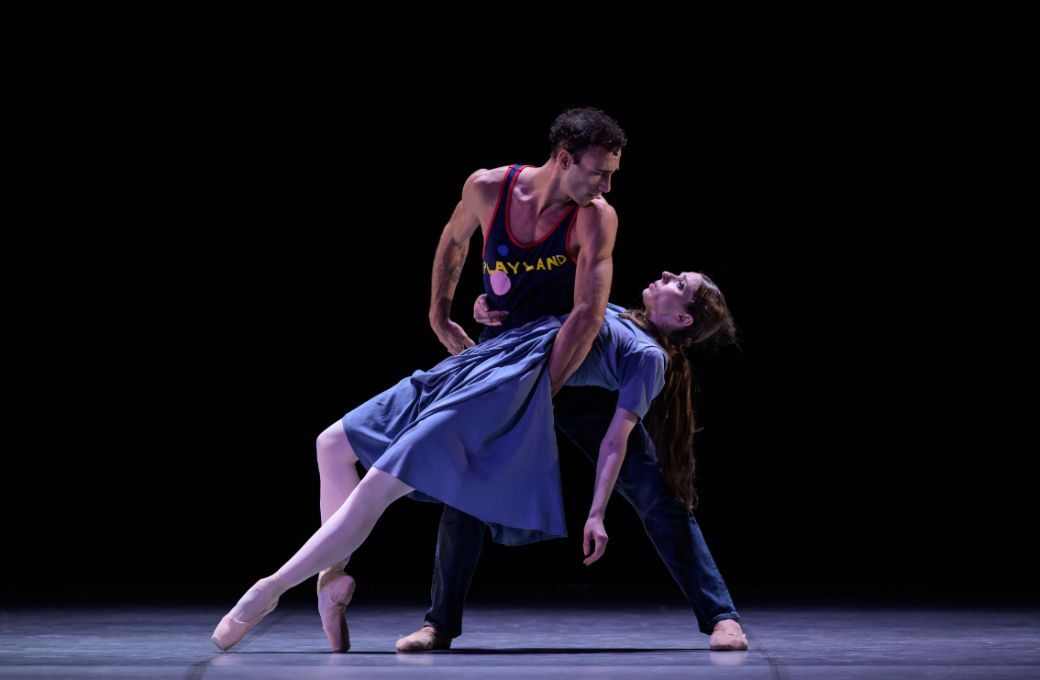Anyone who knows Rodgers and Hammerstein’s Carousel will be familiar with Liliom, since both musical and ballet stem from the same source of Ferenc Molnár’s 1909 Hungarian play.

In 2011, John Neumeier produced his interpretation of Liliom for Hamburg Ballet, the company he directed for 51 years prior to his retirement in 2024. He had long wanted to make a work with the composer, Michel Legrand, not knowing that the latter shared the same desire. A mutual friend spotted the synergy and brought them together to create this spectacular, cinematic work, in many ways more theatre than ballet.
Legrand’s memorable score is played by an orchestra in the pit and a jazz band perched above the backstage together with an itinerant accordionist. The result is a musical tag team with luscious themes passed from one to the other in a continual musical carousel.
This is the first time that Neumeier has allowed his special ballet to be performed by another company, Czech National Ballet. In a speech after the first premiere, he described this as “giving it away,” which he confessed to doing with some sadness.
Despite its floral suggestion, Liliom is a Hungarian colloquialism for “tough guy” and – like Billy Bigelow in Carousel – the title character is a macho, womanising fairground barker. Underneath the bravado there is a kinder heart but he’s unable to let it show. This anti-hero may be unable to land the killer blow in his fight with a drunken sailor, but he can still abusively strike both his lover and their child.
In the first premiere, Giovanni Rotolo brought a pot-boiling physicality to the title role, whereas on the following evening, Paul Irmatov emphasised both devil-may-care confidence and the inner torment of concealing any tenderness. Both performers gave great attention to detail (absorbing eight weeks of preparation with Neumeier) particularly in regard to the drama’s psychological aspects.
Liliom is set in America during the Great Depression, the desperation of that period illustrated by queues of anxious men, some carrying placards pleading for a job. The wording on each placard was authentically reproduced from contemporary photos of men seeking work during that Grapes of Wrath era.
Having been sacked by his boss and lover, Mrs Muskat, Liliom joins the unemployed and in desperation he is persuaded by the crooked Ficsur to take part in a bungled attempt to rob his former employer. Cornered by the cops, Liliom kills himself and then spends 16 years in purgatory but is allowed to return to earth to meet Louis, the son he never saw in life. In a nod to his villainous past, he steals a star to give to Louis.
Liliom’s saviour is the devotion of the long-suffering Julie, portrayed at that Hamburg premiere by Neumeier’s muse, Alina Cojocaru. Here, another Alina (Nanu) took the first premiere, and I can give no greater praise than to report how much Nanu reminded me of her namesake. She has the same waif-like vulnerability aligned to a determination to keep her man against all odds, echoing Cojocaru’s highly tuned sense of dramatic expression. Aya Okumura made no attempt to follow suit, instead giving a different but nonetheless outstanding interpretation, more maternal and intense. Both were heartrendingly poignant in their respective solos after Liliom’s suicide, rivalling the crypt-scene in MacMillan’s Romeo and Juliet for its coruscating emotional pull. Legrand’s oft-repeated theme for Liliom and Julie is beautiful but ends appropriately with an unexpected dissonant chord.
Both casts were brimming with outstanding performances. Kristina Kornová and Kristýna Němečková captured the haughty, seductive beauty and sharp angular lunges of Mrs Muskat. Javier Wong, a former Royal Ballet School pupil, was a believable 16-year-old Louis, contrasting excellently with the physicality of Rotolo as the spirit of his father; in the second cast, the boyish charm of Jakub Rašek was no less effective but being roughly the same height and build meant that the contrast with Irmatov was less marked. One sensed more clearly with Rašek that he was on the same self-destructive path as his father – indicated by wearing his fairground barker costume in the finale.
No amount of preparation can account for a last-second illness, and this meant a rapid cast change on the opening night in the key support roles of Wolf and Marie, such that Federico Ievoli and Nina Fernandes performed in both casts. They enjoy a quickfire romance: meeting by chance, dancing together in a strong romantic duet and then marrying in the next scene! Spare a thought for Elena Dombrowski, a dancer from the corps due to experience her first soloist role as Marie, having to drop out with just minutes to go when her partner became unwell.
This production enjoys a new set design by Ferdinand Wögerbauer, with a more realistic carousel than in Hamburg and plenty of fairground motifs in the Playland scenes. Two clowns are prominent throughout: the first being the balloon man, a tall white-faced performer in the manner of Marcel Marceau, carrying a fistful of balloons and acting as a liminal guide between the human and spiritual worlds – John Powers and Ole Johannes Slåttebrekk were equally striking; and the sad-faced loser, based on a real 1930s American clown, Weary Willie, a leitmotif for depression, often trying to pick up his hat but inadvertently kicking it out of reach.
The combination of Neumeier’s attention to detail and his expressive movement motifs, together with Legrand’s cinematic score, has created another modern masterpiece from Molnár’s century-old play. Neumeier needn’t have worried about giving his ballet away since the Czech National Ballet has honoured his creation with superb back-to-back performances.
Graham's trip was funded by Czech National Ballet


